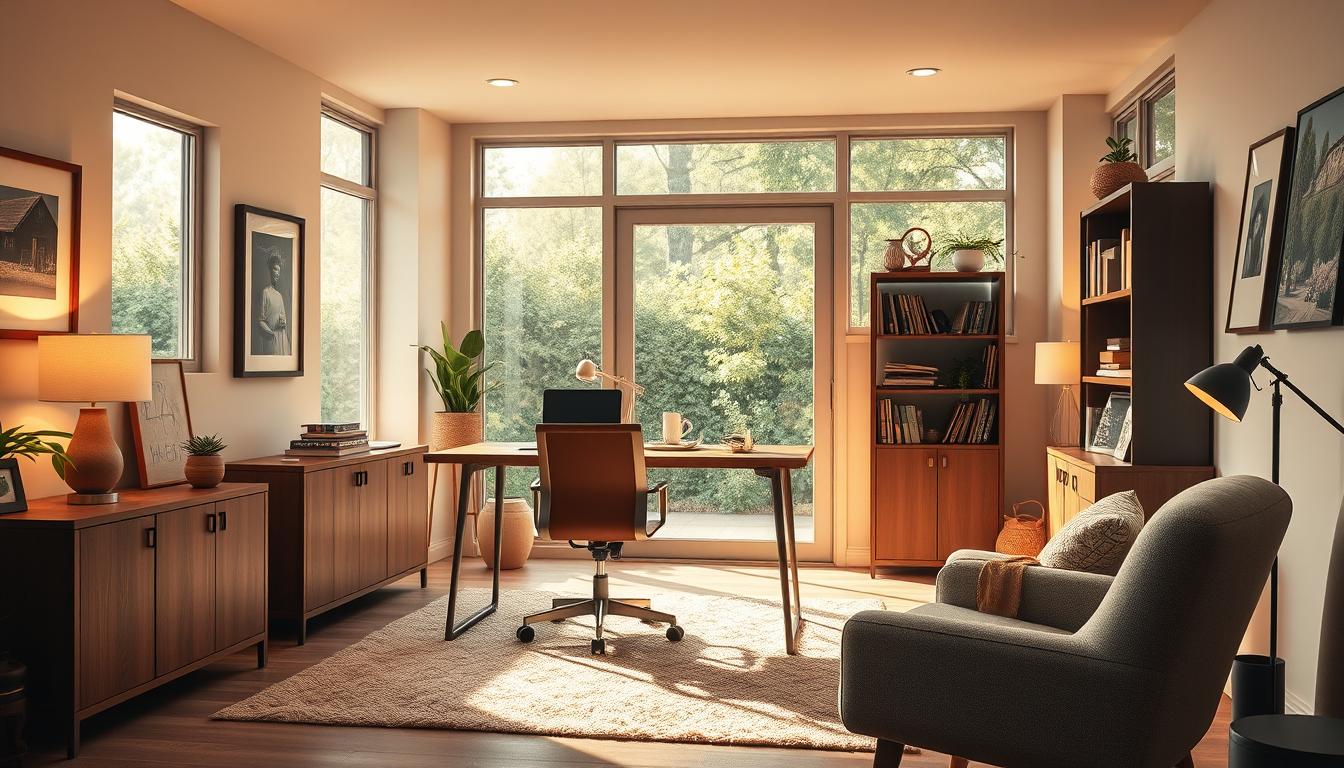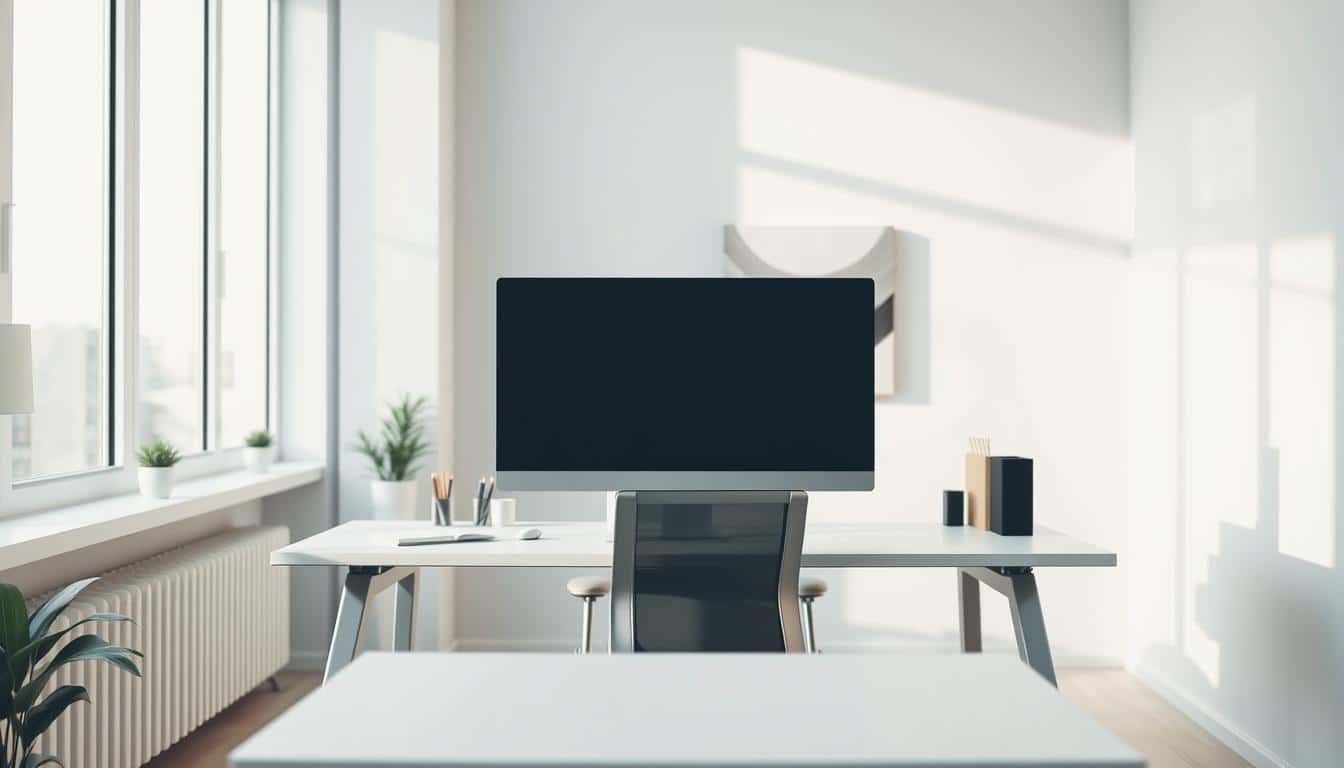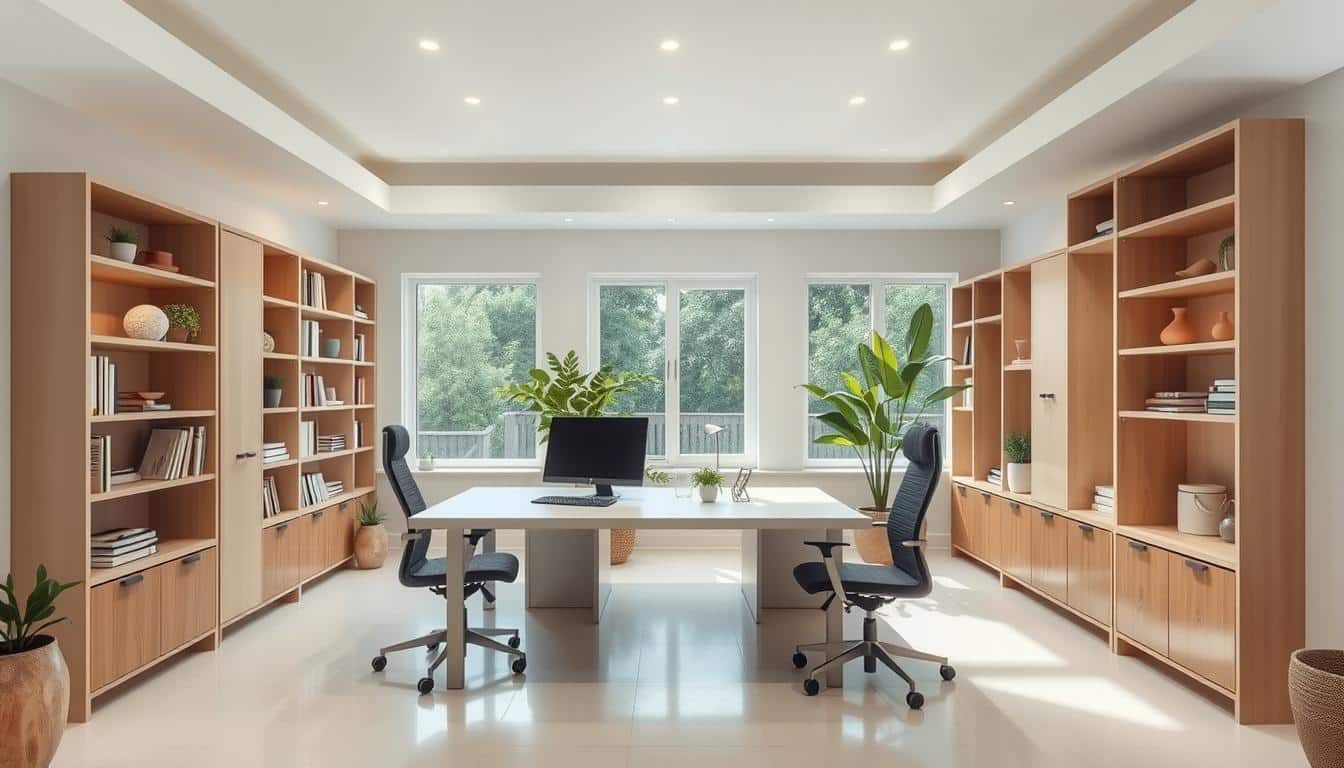In today’s fast-paced work environment, having an ergonomic workstation is crucial. It ensures comfort at work and improves overall workplace health. People spend many hours seated at their desks, making it essential to have effective office ergonomics.
This boosts productivity and cuts down the risk of musculoskeletal injuries. We’ll explore the main parts of an ergonomic workstation. These practices enhance comfort and promote a healthier work-life balance.
Understanding Ergonomics
Ergonomics focuses on aligning workers with their workspaces in harmony. It studies how to modify tools and tasks for individual needs. The main aim in workplace ergonomics is boosting safety, comfort, and productivity.
Bad ergonomic practices can cause serious health issues, like injuries from repeated movements or bad posture. Ergonomics is more than looking good; it’s about adjusting workspaces to support natural body positions.
To avoid injuries and promote health, everyone must apply ergonomic design principles. Knowing about ergonomics can make a big difference in work life, improving both personal health and job efficiency.

The Importance of a Comfortable Workspace
A comfortable workspace is key for boosting productivity and keeping employees healthy. An ergonomically designed workstation cuts down on discomfort. This helps workers stay focused. If the setup is poor, workers might get distracted, hurting efficiency.
Making the workspace comfortable helps with focus and creativity. If employees are pain-free, they’re happier and more satisfied with their jobs. This not just lifts spirits but also cuts down on costs related to injuries.
Companies that focus on ergonomic workspaces have fewer accidents and sick days. A well-thought-out workspace does more than make things comfortable. It builds a culture that values well-being, helping everyone do their best.
Choosing the Right Chair
Picking the right ergonomic chair is key for a healthy work space. It boosts comfort and encourages correct sitting. Lumbar support is crucial, supporting your spine well. Here’s what to keep in mind when selecting your chair.
Support for Your Spine
An ergonomic chair needs to fit your spine’s curve. Good lumbar support lessens discomfort from sitting long hours. Seek chairs with adjustable lumbar settings. They should fit your back’s shape and keep your spine aligned.
Adjusting Chair Height
Setting your chair height right is vital for good posture. It should let your feet stay flat on the ground. Your knees should be at a 90-degree angle. This eases lower back pressure and betters your posture over time.
Armrest Positioning
Armrests matter more than you might think in ergonomic chairs. They help avoid shoulder stress. They should let your arms rest without raising your shoulders. This makes for a relaxed, natural way to sit.
Desk Setup for Optimal Posture
An optimal desk setup greatly improves comfort and work efficiency. The right desk height keeps your wrists straight while typing. This prevents discomfort and helps you work better.
Height Considerations
Your desk should match the height of your elbows when seated. Adjustable desks are great because they fit everyone’s needs. Use a footrest if your desk is not the right height.
Under-Desk Space
Keep the space under your desk clear for your legs. This lets you move freely and avoid feeling cramped. A tidy under-desk area also helps you work more efficiently.
Ergonomic Workstation Components
Creating an ergonomic workstation isn’t just about the chair and desk. It also includes how you place your keyboard and mouse. By setting these devices up correctly, you can avoid strain and injury. This makes working more comfortable and productive.
Keyboard Placement
It’s important to place your keyboard correctly to prevent discomfort. Here’s how to make your setup ergonomic:
- Keep the keyboard at elbow height for comfortable arm positioning.
- Place the keyboard close enough to prevent reaching and keep your wrists neutral.
- If regular keyboards cause discomfort, try a split keyboard for a natural hand position.
Mice and Input Devices
Choosing the right mouse and input devices is key to comfort at the computer. Look for ergonomic designs that fit your hand’s grip. Here are some tips:
- Keep the mouse on the same level as the keyboard to avoid shoulder strain.
- Try using vertical mice or trackballs to reduce wrist twisting.
- Remember to take breaks often. Adjust your devices as needed for comfort.
Monitor Placement and Setup
Setting up your monitor right is key to being comfy and avoiding eye strain. Having it set up well can make you more productive and keep you healthy in the long run. The right distance and height of the screen are super important for a good viewing experience.
Distance from Your Eyes
Your monitor should be 20 to 30 inches away from your eyes. This distance helps reduce eye strain. Adjust it depending on your screen size and how well you can see.
Screen Height Adjustments
The height of your monitor matters for how you look at it. Your screen top should meet or be a bit under your eye level. This keeps your neck comfy and strain-free.
Adjust the height with monitor stands if you need to. Also, keep your screen away from direct light to cut down on glare. This makes your screen easier to see and helps you work better.
Laptop Considerations
Laptops are great for moving around, but they can make you sit in bad positions. Using things like an external keyboard and a laptop stand helps fix that. These accessories help keep your body in the right position and make using your laptop more comfortable.
Using an External Keyboard
Adding an external keyboard changes everything if you’re always on your laptop. It lets you keep your hands level with your elbows. This means less strain and better typing form. A good external keyboard makes working on your laptop better and keeps you comfortable.
Importance of a Laptop Stand
A laptop stand lifts your screen to where your eyes are. This is key to keeping your head and neck happy. It stops you from bending over too much and eases strain on your back and shoulders. A stand also keeps your laptop cool by letting air flow better. Using a stand makes your laptop use healthier for you.
Organization for Efficiency
Organizing your desk well boosts efficiency and makes for a comfy workspace. By placing things smartly, you dodge unnecessary strain. A few smart moves can lift your productivity and make workdays feel better.
Keeping Frequently Used Items Close
Easy access to what you need is central to a good setup. Keep must-haves like pens and notes nearby. This cuts down on time hunting for stuff and awkward reaching. Desk organizers or drawer dividers are great for keeping things tidy.
Reducing Reach and Strain
Smart placement is vital for desk work. Make sure you can reach your mouse, keyboard, and papers easily. This prevents the need to stretch or twist. A document holder keeps your papers at eye level, saving your neck from pain.
- Place frequently used devices, such as phones or tablets, right next to your workstation.
- Utilize vertical space with shelves or wall-mounted racks to keep the desk surface clutter-free.
- Incorporate cable management solutions to prevent tangling wires, enhancing both aesthetics and functionality.
Lighting and Its Effects on Health
Having the right lighting at work is crucial for both comfort and productivity. Bad lighting can cause eye strain, making it hard to focus on tasks. But, if you pick ergonomic lighting, this problem can lessen a lot.
Ambient and task lighting are the main types you’ll find in workplaces. Ambient lights brighten the whole area, while task lights focus on specific spots for detailed work. Getting the balance right between these lights can make things clearer and reduce glare, which often hurts our eyes.
Here’s what to think about when fixing your lighting:
- Set up lights so they don’t cause screen reflections or eye discomfort.
- Let in as much natural light as you can, it makes the area lively and lifts your mood and energy.
- Get adjustable lamps for your desk. They help you see better without being too bright.
Choosing your lighting wisely can lead to a workspace that’s both comfy and efficient. It lowers the risk of hurting your eyes, too.
Incorporating Movement into Your Workday
Moving around during your workday keeps you healthy and happy. When you sit for too long, you can feel tired and stiff. Taking short breaks helps refresh your mind and body, making you more focused and efficient. Doing simple stretches helps your blood flow better. This can prevent pain and make you feel more comfortable.
Importance of Breaks
Taking breaks is important to keep your energy up. Walking away from your desk for a little while can help your brain work better when you return. Here’s why breaks are good:
- Reduction of eye strain from screen time.
- Prevention of musculoskeletal issues commonly associated with long periods of sitting.
- Support for mental clarity, leading to more productive work sessions.
Simple Stretching Exercises
Stretching during the day is very helpful. It promotes movement at work and only takes a few minutes. Consider trying these stretches:
- Neck Stretch: Gently tilt your head towards one shoulder, hold for a few seconds, and switch sides.
- Shoulder Rolls: Rotate your shoulders forward and backward in a circular motion to relieve tension.
- Wrist and Finger Stretch: Extend your arm, palm up, and pull back on your fingers with the other hand for a good stretch.
Simple exercises like these improve your flexibility and lower your chance of getting hurt from strain. Remember, moving around during your workday is important for staying healthy and being productive.
Additional Accessories for Comfort
Adding extra items to your ergonomic setup can make a big difference in comfort and support. Palm and wrist supports are key for keeping your hands right while typing or using a mouse a lot. For those who often look at printed stuff, document holders are a must. They make sure you can read without bending too much.
Palm and Wrist Supports
Palm supports help keep your wrists comfy and straight when you type, fighting off pain and injury risks. These tools ensure your wrists stay in a good spot, leading to a smoother work day. Using them often might help you type better and feel great overall.
Document Holders
Document holders keep your papers well-organized and at the right height. They stop you from having to move too much or hurt your neck. By making it easy to look at your screen and papers at the same time, you might work faster. Picking the right document holder can change the way you deal with printed documents.
Conclusion
Making your workstation ergonomic isn’t just a trend. It’s key to keeping the workplace healthy for everyone. By choosing the right chairs and setting up desks properly, we can all work more comfortably and effectively.
When companies invest in ergonomic setups, they help prevent injuries and increase productivity. Creating a work culture that supports ergonomic practices leads to healthier staff. This means less time off work and happier employees.
In short, moving to an ergonomic workplace has lasting benefits. It’s important for organizations to focus on solutions that look after their team’s health. This helps create a better and more productive work environment for everyone.



